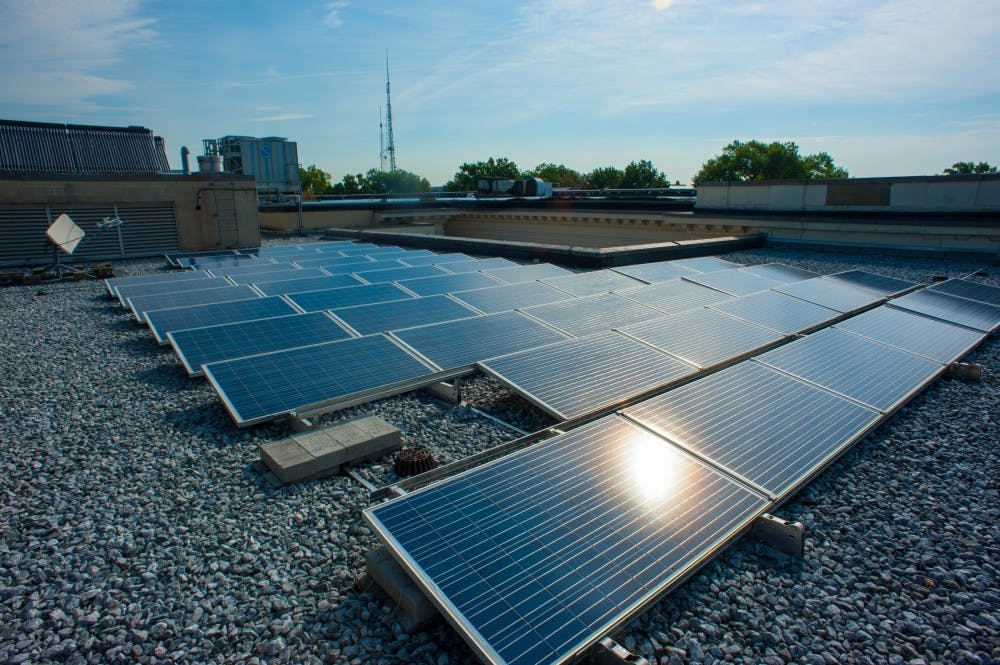Correction appended.
Three new solar arrays in North Carolina will begin contributing more than half of the amount of energy AU consumes by the end of 2015.
AU is partnering with George Washington University and George Washington University Hospital to bring North Carolina’s sunshine into its academic buildings through the Capital Partners Solar Project. The project will break ground this summer and is set to be completed by the end of 2015, according to the press release.
The project will include 243,000 photovoltaic panels, commonly known as solar panels, that will be installed on three different sites in North Carolina. The solar panel arrays will offset 60,000 metric tons of carbon dioxide, according to a press release from AU Public Relations Manager Rebecca Basu.
“American University is firmly on its way to achieving carbon neutrality by 2020,” President Neil Kerwin said in the press release. “We are home to the largest combined solar array in the District, are resolved to growing green power through our purchase of renewable energy certificates and are now a partner to the largest non-utility solar energy purchase in the United States.”
The three institutions entered a 20-year agreement for a fixed price on solar energy. The total price of the project is estimated to be lower than predicted increases in energy prices during that same timeframe, according to the press release.
AU has purchased Renewable Energy Credits since 2011, which replace the potentially “unclean” energy consumed by AU from the District of Columbia’s regional power grid with an equal amount of clean wind or solar energy on the national grid, according to AU’s Carbon Neutral by 2020 brochure. However, AU does not directly use the wind and solar energy it purchases with the credits.
Power grids pull energy from multiple sources, including hydroelectric dams, nuclear power plants, coal-firing power plants, natural gas power plants, wind and solar. The credits allowed AU to replace any “dirty” energy it used from the grid with with absolutely “clean” energy without technically using the “clean” energy on campus, The Eagle previously reported.
Capital Partners Solar Project will allow the solar energy produced in North Carolina to flow onto the District’s regional power grid, on which AU’s campus sits.
However, AU still cannot just draw solar power from the regional power grid. The solar energy from North Carolina will be mixed with all the other forms of energy on D.C.’s power grid, including energy from fossil fuels. The University will only be able to pull solar energy directly from solar panels on its buildings.
AU will draw 30 million kilowatt-hours from the solar arrays, while GWU will pull more than double that amount at 86.6 million kwh, according to the press release.
The project is a step towards reducing AU and GWU’s carbon footprints in accordance with American College and University President’s Climate Commitment, which Kerwin and GWU President Steven Knapp signed. The solar project also aligns with Mayor Vincent Gray’s goal to turn D.C. into one of the “greenest” cities, The Eagle previously reported.
Fossil Free AU and Fossil Free GW, however, do not believe that the investment in the Capital Partners Solar Project reconciles the universities’ continued investment in fossil fuels, according to a joint press release from the Fossil Free groups on June 24.
Fossil Free promotes the removal of fossil fuel companies from university investment portfolios, also known as divestment, as a way to have a significant impact on climate change.
The groups applauded AU and GW’s new commitment to renewable energy, but found the universities’ continued investment in fossil fuels to be contradictory.
“Both GWU President Steven Knapp and AU President Neil Kerwin have made statements promoting this project’s value towards their institution’s respective carbon neutrality goals,” according to the press release. “But as long as both universities continue to hold investments in fossil fuel corporations, carbon neutrality remains unacheivable.”
The project is being carried out by Duke Energy Renewables and CustomerFirst Renewables, according to AU Public Relations press release. Duke Energy Renewables is a part of Duke Energy, which is the largest electric power holding company in the United States that aims to provide gas and electricity through sustainable measures, according to their website.
Richard W. Blackburn, who is on GWU’s Board of Trustees, is a retired executive vice president of Duke Energy, according to a Feb. 25 announcement from GWU.
“Until our investment policies reflect our sustainability initiatives,” according to the Fossil Free groups’ press release, “our universities will remain complicit in climate change.”
A previous version stated AU and GWU’s carbon neutrality goal was to reduce their carbon footprints by 40 percent by the year 2025. That is GWU’s goal. AU’s goal is to be carbon neutral by 2020.





